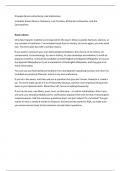El papel de las costumbres y las tradiciones
Included: Exam Advice, Flamenco, Los Corridos, El Día de los Muertos, and the
Quinceañera.
Exam advice
Only two hispanic traditions are required for the exam; these could be festivals, dances, or
any number of traditions. I’ve included these four for variety, but once again; you only need
two. Try not to pick two with a similar history.
If you want to research your own festival/dance/tradition, then focus on its history, its
components, its terminology, its use in history, its use nowadays and whether it is still as
popular as before. It should be available on both English and Spanish Wikipedia; of course,
the Spanish Wikipedia isn’t just a translation of the English Wikipedia, and may give a lot
more information.
You can use any festival/dance/tradition from any Spanish-speaking country; the ones I’ve
included are primarily Mexican, which is my own preference.
If you’re in the exam, and they ask you a question that you don’t know; freestyle it, make it
up. Try not to make up all of it or it’ll be pretty obvious, but the most important thing in the
exam is your Spanish skills. Show them off, focus on talking eloquently.
If you’re not sure, use fillers; pues, hum, yo diría que... or ask for clarification. Even if you
are sure, you should probably ask for clarification anyway from time to time; it shows good
responsiveness. Ask the examiner questions back; not just sabes? Or y tú/usted? You get
marks for this; a whole 6 marks for Edexcel, and around the same for AQA, so make sure
you communicate back to the examiner and ask them questions.
, Flamenco
Originated from Andalusia in 18th century, from mixture of the different cultures in the
region; mostly gypsies but also Jews, Muslims, and Andalusia Christians (mozárabes).
El cante
Camarón de la Isla was considered the best cantaor of contemporary flamenco and one of
the most important figures of flamenco. However, he was also a very sickly figure due to
drug addiction. Died at 41 due to heart cancer, with his death causing huge commotion.
El toque
Paco de Lucía was considered the best contemporary flamenco guitarist. Together with
other artists such as Tomatina and Camarón de la Isla, he modernised classic flamenco
whilst conserving its key attributes. Paco died at 66 in Playa del Carmen, Mexico.
El baile
The person who dances is called the bailaor. Their role is to interpret the lyrics through
movement of the body, arms and legs, zapateos (taps of the shoe) and facial expressions.
La improvisación
Improvisation is more common in el toque and el baile and requires great skill. Paco and
Camarón were admired due to their use of improvisation.
Duende
When a bailaor, cantaor or tocaor has duende, they have an almost perfect talent that
enraptures the audience.
La importancia del flamenco
Historically it has played a crucial role in the lives of the Andalucians, as a means of
expressing themselves or protesting injustices. During the Franco dictatorship, it was
made into a symbol of Spanish nationalism, and shown in festivals, tv and parties amongst
others. During this period, it was adapted and censored by the government; cantaores who
showed opposition towards the injustice and repressive nature of the regime suffered
persecution and repression. Nowadays, it is one of the most important genres of music in
Spain and popular worldwide- just in Japan, there are more Flamenco schools in Tokyo
than in the entire of Spain. It provides enormous economic benefits, supplying jobs and
tourism, as more than 700.000 flamenco tourists land in Spain each year and spend more
than 500 million euros, and 10% of concerts in Spain are dedicated to flamenco.




